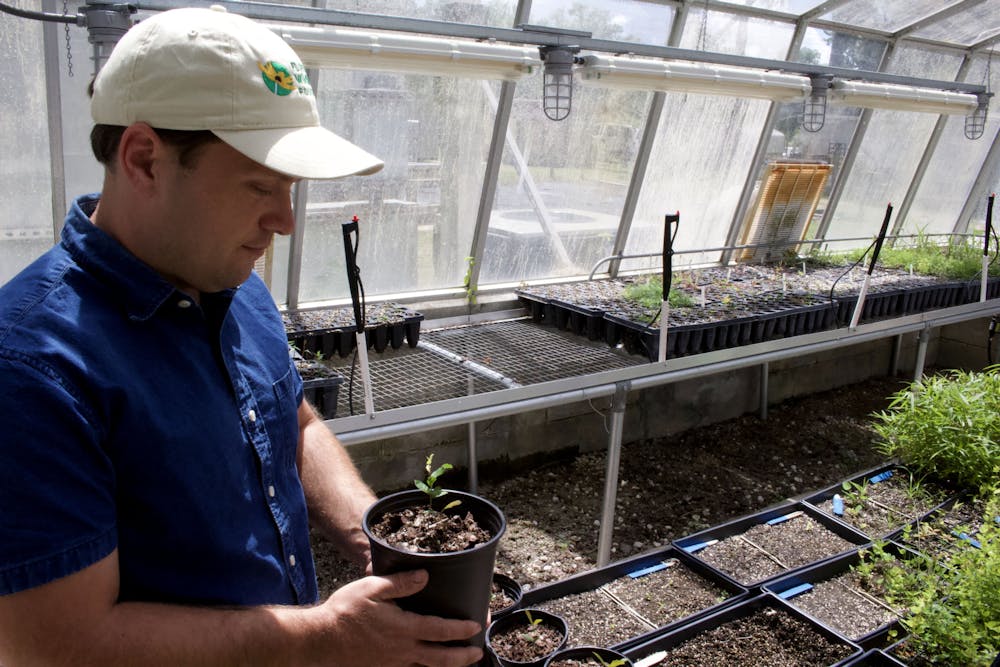The massive Norman Hall oak tree had been the centerpiece of the UF College of Education’s courtyard for over a hundred years.
Students and staff often took group photos beneath its leaves. Others used its shade to escape the sun on summer days — that is, before it was uprooted by Hurricane Helene in September 2024.
The tree’s loss shocked many.
Kevin Coulson, the assistant director of communications for the College of Education, said the oak served as a symbol for the college’s goals.
“Over time, it became part of the fabric of the college and showcased the growth and networking that happened here,” Coulson said.
With it gone, the College of Education now has the opportunity to entirely recreate its courtyard.
“We get to think about even bigger structural opportunities — restructuring the faces of buildings, potentially reorganizing the flow of foot traffic,” he said.
To breathe new life into the beloved tree’s legacy, the College of Education and the Institute of Food and Agricultural Sciences are collaborating on a tree-planting project.
Gage LaPierre, the head of UF IFAS’ Native Plant Nursery, is a part of the team spearheading the initiative, which began early last October in the aftermath of the hurricane. While the damage to the tree was irreversible, a team of UF faculty members and students saw an opportunity to replace what was lost by replanting the tree’s acorns.
They collected approximately 1,000.
The majority of the acorns were green and immature at the time of collection, LaPierre said.
“When they got to me, I really didn't think they were going to grow,” LaPierre said. “But we decided to just try and see.”
The process consisted of densely planting the acorns in large plastic containers filled with soil.
The team then allowed for a dormancy period in an attempt to break the natural cycle of the seeds. This process, called cold stratification, means the seeds were left outside throughout winter. By being exposed to cold and moisture, the seeds change internally, signaling they can start sprouting when conditions improve.
Despite LaPierre’s doubts, small leaves began to unfurl from the soil in March — a sign of unexpected success.
The project yielded around a dozen live sprouts, and another dozen will likely bloom in the coming weeks. The sprouts were transplanted into 1-gallon pots and now reside in a greenhouse at the UF Plant Nursery, where they are protected from pests and other environmental disturbances.
A press release from the College of Education announced the sprouts’ future is still uncertain. They may be replanted in the newly imagined Norman Courtyard, or the seeds might be given to major donors of the Finding Touchstones campaign, which is taking donations to support the revival of the courtyard. The campaign aims to create a vibrant gathering space that honors the tree’s memory.
UF faculty and students hope the Norman oak's legacy will continue.
Madison Rassbach, a 23-year-old UF alumnus and graphic designer at the College of Education, said she’s excited by the possibility of new trees.
“At my office, we would take new staff's photos under the tree, and it was a big part of the College of Education,” Rassbach said. “To know that it's being preserved and possibly regrown is really amazing.”
Samantha Noll, an evening and weekend supervisor at the Education Library, said many of her colleagues at the library are saddened by the loss of the Norman oak because of its beauty and rich history. As a Gainesville native, many of Noll’s family members attended UF and made memories with the tree.
“One of them told me how she used to eat lunch under the Norman tree every day and how it always lifted her spirits in an otherwise stressful time,” Noll said. “I’m so glad to know that some of the acorns will be replanted, and I look forward to watching them grow.”
Contact Swasthi Maharaj at smaharaj@alligator.org. Follow her on X @s_maharaj1611.

Swasthi is the Fall 2025 university administration reporter. She's previously worked as general assignment reporter with The Alligator, and you can also find her work in Rowdy Magazine or The Florida Finibus. When she's not staring at her laptop screen or a textbook, she's probably taking a long walk or at a yoga class.






